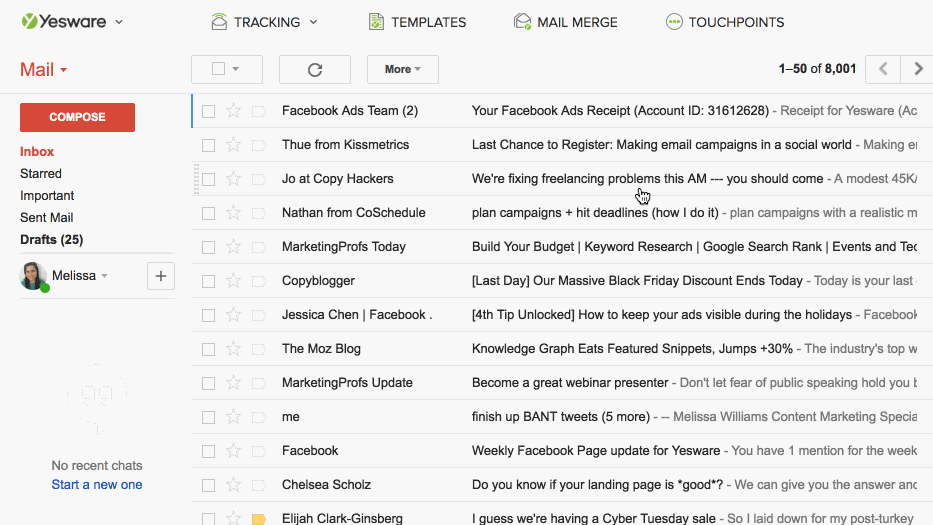Managing emails is a time-consuming task.
Did you know that an average professional receives 121 emails every day?
For most working people, as much as 28% of their workweek is spent simply writing, reading and replying to emails.
It’s no surprise then that we are constantly overwhelmed by emails — and as a result, we become less productive at work.
But it doesn’t have to be this way.
If you’re able to bring structure and organization to how you manage emails, life becomes easier.
You’ll have more time for yourself and will have a greater ability to produce more impactful work.
Let’s take a look at some proven email management tactics and strategies.
- 1. Allocate Email Time in Your Calendar
- 2. Create Labels, Folders, and Categories
- 3. Touch It Once
- 4. Follow the 1-minute Rule
- 5. Read Top Down, Write Bottom Up
- 6. Knowing When to Send Emails
- 7. Convert your Group Email Accounts into Shared Inboxes
- Email Management FAQs (Frequently Asked Questions)
- Wrap Up
Download this post by entering your email below
1. Allocate Email Time in Your Calendar
Just as you make time for yourself, set aside structured time for your emails in your schedule.
It’s important to do this because an average worker checks their email close to 74 times daily!
That’s a LOT of time, energy, and effort used up in doing something that doesn’t necessarily need so much mental bandwidth.
But here’s the thing: emails might not seem as intrusive as a phone call, but they end up creating far more stress.
As working professionals, we often worry about them, keep checking our inboxes, and end up losing focus on things that matter.
So, that brings us to the most fundamental strategy: allocate a fixed time every day to deal with email.
You could do this at one stretch or schedule blocks of time throughout the day just for email.
Ideally, avoid multitasking when you’re checking emails. That’s because when you minimize distractions and stay focused, it becomes easier to run through everything.

Tim Ferriss discusses a great email template hack in his bestseller The 4-Hour Work Week:
“Due to high workload, I am currently checking and responding to email twice daily at 12:00 pm ET [or your time zone] and 4:00 pm ET. If you require urgent assistance (please ensure it is urgent) that cannot wait until either 12:00 pm or 4:00 pm, please contact me via phone at XXX-XXX-XXXX.”
The takeaways here are pretty simple yet profound.
First, emails can wait. Second, if it’s super urgent, DO NOT send an email. Instead, pick up the phone.
2. Create Labels, Folders, and Categories
One way to simplify email management is through organization. This involves setting up labels, folders and categories.
Keep in mind that there’s no standard rule that applies to the creation of categories.
It would depend on the person, the emails they receive, and how they’d best want to segregate their messages.
For example, someone in finance might need multiple folders. One for invoices, one for reimbursements, and so on.
An employee in marketing could have folders such as inbound, guest post requests, advertising, etc.
The key is to prioritize, group, and sort emails into categories.
The greatest benefit to organizing your emails in this manner is that it becomes very easy to locate specific emails in just a few clicks.
In addition to creating basic folders, you can also set up parent categories and create subcategories under them.
To do this in Gmail, for instance, head to your inbox and look at the left sidebar menu in full view.
Under the “categories” tab, you’ll find “manage labels”. Click on “create a new label” here.

Every label you create is basically a folder. So give it an appropriate (search-friendly) name.
Gmail also allows you to assign different colors to your labels.
3. Touch It Once
The touch-it-once principle is based on making quick decisions in handling emails.
It is also known as the Only Handle It Once (OHIO) method.
The idea here is that revisiting an email over and over again is a waste of time.
So, you touch it once, take action on it, file it away and then move on to the next email.
The touch-it-once principle may seem like it’s easy, but it can get a little hard to follow when it comes to email because we tend to defer replying to emails.
But having this mindset is important since most of us deal with large volumes of email every day.
This will keep you from constantly getting distracted by the thought of unanswered emails, which can dramatically lower your productivity.
4. Follow the 1-minute Rule
The one-minute rule helps you manage both your emails and time better.
Here’s what it entails: if it takes just a minute to respond to an email, do it immediately.
This way, you don’t sit on emails that can be acted upon instantly and filed away. Doing this also clears up your inbox faster.

A variation of this is the two-minute rule — introduced by David Allen, the author of Getting Things Done.
The concept here remains the same: if it only takes 2 minutes to reply to an email, get it done right away.
5. Read Top Down, Write Bottom Up
Atish Davda, CEO of EquityZen, proposes a unique way to get through your inbox.
Read emails by threads in reverse chronological order and respond to them in chronological order.
According to Atish Davda:
“This nuanced hack takes advantage of the fact that some folks respond to emails immediately, sometimes triggering an email ‘tennis match’, eating up that hour you set aside to tackle your whole inbox, and leaving you feeling behind. If you respond to emails in chronological order, you’re less likely to get caught up in back-and-forth emails, and more likely to stay on track.”
6. Knowing When to Send Emails
Email management is as much about the kind and volume of emails you send as it is about the kind and volume of emails you receive.
There’s a famous saying: If you want to receive fewer emails, send fewer emails.
When it comes to sending them, it would depend on the nature of your work.
That’s because there are certain functions where employees do most of their daily work on emails.
Those working in customer success, for instance, have to reach out to existing clients regularly. Usually, email is the preferred channel for this.
In such a role, make sure that you keep your communications crisp and clear.
One of the ways you can send fewer emails is to choose what conversations you want to have through email and which you want to have over a call.
If you’re simply informing a customer about an update, email would work.
But, if you want to check in with a customer and find out what they feel about using your product or service, do that over a call. Otherwise, this could result in a lot of back and forth over email.
For functions such as Sales and Lead Gen (teams that send emails in bulk), you need to confirm whether or not your emails are being delivered properly.
If your emails hit the spam folder or bounce frequently, then there’s a chance your domain gets blocked.
That’s why using a tool to verify email addresses can be useful.
This way, you can be sure that you’re emailing the right person, and that your time and energy is not being wasted.
7. Convert your Group Email Accounts into Shared Inboxes
Most companies have group email accounts such as info@<companyname.com> and support@<companyname.com>.
They make it easier for people on the outside to get in touch with your brand.
But here’s the thing: group emails can get as annoying and overwhelming as WhatsApp groups.
There’s a steady stream of incoming messages in such email accounts which is made worse by the fact that there’s no easy way to assign emails to individuals and keep track of these tasks.
You need to be able to streamline emails arriving in group inboxes and have organized workflows so that there’s less clutter and every team member is clear on what email they need to work on.
Here’s where an email ticketing system like Hiver can be useful.
It helps you manage customer support shared inboxes right from your Gmail inbox.
You get to easily assign emails as tasks to anyone on your team in just a click — without using forwards.
You can also have back-and-forth internal communication without writing more emails.
Email Management FAQs (Frequently Asked Questions)
What is meant by email management?
Email management refers to the practice of organizing, prioritizing, and handling emails in a way that optimizes productivity and efficiency. It involves strategies for managing incoming emails, responding promptly, and organizing email archives for easy retrieval.
What are the 4 D’s of email management?
The 4 D’s of email management are:
Delete: Discard irrelevant or unimportant emails immediately.
Delegate: Assign emails that can be handled by someone else to the appropriate person.
Do: Respond to emails that require immediate action.
Defer: Postpone dealing with emails that require more time or consideration to a later time.
How to manage 100 emails a day?
- Set specific times throughout the day to check and respond to emails.
- Use the 4 D’s method to quickly process and prioritize incoming emails.
- Utilize email management tools or software to automate repetitive tasks and organize your inbox.
- Consider batching similar tasks together to increase efficiency.
- Implement filters or rules to automatically categorize and sort incoming emails.
- Focus on addressing high-priority emails first, and defer less urgent ones to later.
Wrap Up
There’s no standardized approach to managing emails, so it’s important to note that not all these strategies will work for you.
You might have to experiment to see which tips are effective for you.
Commit to having structure with your email management and you will begin to see the effects throughout your workflow.
Irrespective of which approach you take, consistency is key if you aim to maintain a clean, organized inbox.
We all know how annoying promotional emails can be. You can create high-value email content and boost your open rates with WriterAccess! Sign up for a free trial now and gain access to a team of expert writers who can help you create professional and engaging email templates.
From crafting concise and compelling messages to implementing effective email strategies, our writers will save you time and ensure your emails are impactful.
This post was written by Ganesh Mukundan, a content marketer at Hiver who loves everything about customer experience and customer service.
Ganesh is passionate about narrating delightful customer stories, researching CX trends, and diving into concepts such as VoC and Customer Journey Mapping.
When he’s not working, Ganesh likes to rap, play football, and binge-watch Nordic TV shows.







